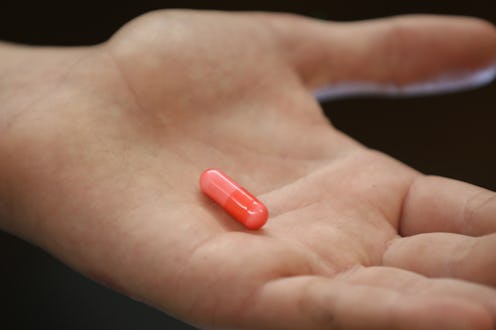News
So... How Does Female Viagra Even Work?
If you're a woman whose sex drive is in the dumps, modern medicine might finally be able to deliver a solution. In a groundbreaking move, a U.S. Food and Drug Administration advisory committee on Thursday recommended the agency approve Flibanserin, a drug intended to increase sexual desire in women. And it's been a long time coming, no pun intended. Women's groups have accused the FDA of sexism for their delay in approving "female Viagra," whereas critics argue that it's more complicated to treat low sexual desire in women and that the drug has numerous side effects. That being said, how does "female Viagra" work, exactly?
Unlike male Viagra, which works by stimulating blood flow to the penis to help maintain an erection, the functions of "female Viagra" or Flibanserin are more similar to an anti-depressant. “The brain plays an important role in regulating a woman's sexual desire, and one of the root causes of persistent and recurrent low sexual desire, or HSDD, stems from an imbalance of neurotransmitters in the brain," wrote Stephen Stahl, MD, Ph.D., of the University of California at San Diego, a professor of psychiatry who is associated with Sprout Pharmaceuticals, the makers of the drug. “Flibanserin is believed to work by correcting this imbalance and providing the appropriate areas of the brain with a more suitable mix of brain chemicals to help restore sexual desire.”
Hypoactive sexual desire disorder, or HSDD, is the disorder that "female Viagra" aims to cure. According to Sprout Pharmaceuticals, HSDD is "a persistent or recurrent deficiency or absence of sexual fantasies and desire for sexual activity that causes marked distress or interpersonal difficulty," and isn't accompanied by another psychiatric or medical condition. According to the North American Menopause Society, HSDD might actually be as common or even more common in pre-menopausal women than post-menopausal women, but young or old, the disorder can be found among all age groups. A total of 8.9 percent of women ages 18 to 44 reported HSDD, compared to 7.4 percent of women ages 65 and older. A total of 12.3 percent of women between the ages of 45 and 64 reported symptoms of HSDD.
The "brain chemicals" that Stahl refers to increase "the downstream release of dopamine and norepinephrine while reducing serotonin release" in the parts of the brain that deal with sexual desire, according to Forbes. If female Viagra sounds like a lot like popular SSRIs like Prozac or Lexapro, which block the reabsorption of serotonin in the brain, you're right.
Adriane Fugh-Berman, a physician at Georgetown who has been tracking Flibanserin told Slate that that the drug was created by the pharmaceutical company Boehringer-Ingelheim as an anti-depressant, but failed to get FDA approval. Critics of the drug, including the American Medical Women's Association, praised the FDA for this decision, pointing to what it said were the drug's "worrisome side effects," as well as the fact that the pharmaceutical company that initially sponsored the drug changed clinical trial methods midway.
Sprout Pharmaceuticals took up the sponsorship of Flibanserin in 2011, and the company has made pushing for the female sexual dysfunction drug's federal approval to be their main focus.
In a letter to the FDA from April 2014, several women groups pointed out the gender bias inherent in male Viagra and "female Viagra." In a nutshell, Viagra for men is taken on an as needed basis and affects men's penises. Meanwhile, Flibanserin is taken nightly in the form of a 100 mg pill and affects women's brains. The letter read:
All but one of the drugs approved for men are taken on an as-needed basis, whereas flibanserin, a central nervous system serotonergic agent with effects on adrenaline and dopamine in the brain, requires chronic -- daily, long-term -- administration. This raises toxicological concerns that make it appropriate for the FDA to subject flibanserin to elevated safety scrutiny.
Staunch supporters of the "pink pill" for female dysfunction point to a 2008 study that suggested that low sexual desire was the most common sexual problem among women, with 38.7 percent of the study's 31,581 respondents reporting low sexual desire, though it's worth noting that the study was funded by Boehringer Ingelheim.
What's next for Flibanserin? The FDA's final decision on Flibanserin is expected by the end of the summer, according to The Washington Post. The FDA advisory committee voted 18-6 to recommend that the FDA approve the drug. The agency in most cases sides with the recommendations of the advisory committee. But that's not a guarantee.
As we learned from Plan B and "The Pill," most drugs intended to better the sex lives of women face a long and rocky ride before they hit our medicine cabinets.
Images: Getty Images (2)
